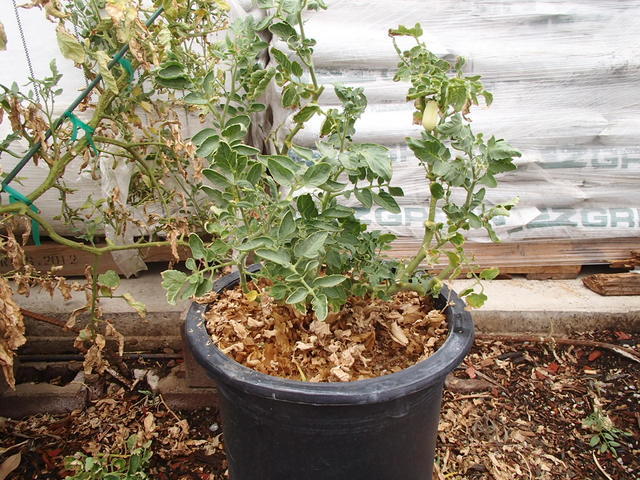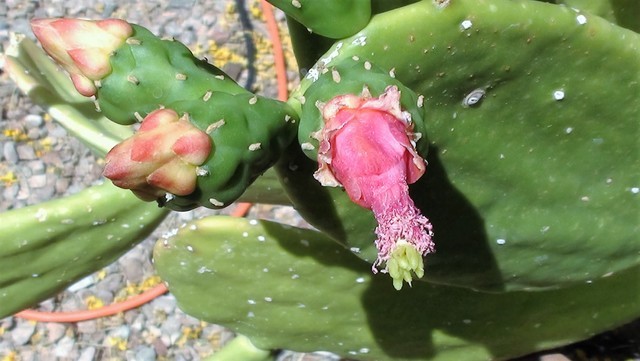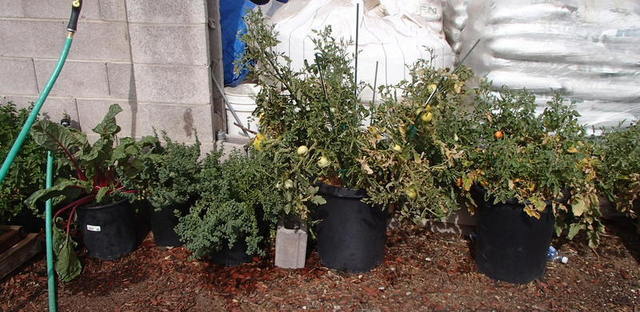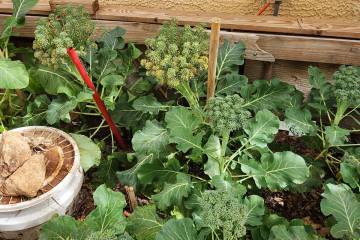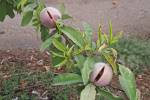Reduce canopy size of tomato plant to promote growth
Q: When do you cut back summer tomato plants to get a second crop in the early fall? I need to know this and any special treatment needed, such as fertilizing, to promote new growth.
A: The concept behind cutting back tomatoes for a fall crop is reducing the size of the plant to stimulate more growth at a time when tomatoes will successfully begin setting fruit again. For tomatoes to successfully produce a crop requires daytime temperatures below 95 degrees F.
These temperatures can occur in midsummer occasionally here but not very often. We normally see these temperatures toward the beginning to mid-September. Tomato plants are reduced in size about three to four weeks before the arrival of these temperatures and then encouraged to grow again. This would place cutting them back around the first part to mid-August.
To get them to regrow is a little bit of an art this time of year. Cutting them back too much can cause the plant to sunburn, and they may never recover because of our intense heat and sunlight.
“Cutting them back” perhaps paints the wrong picture about what to do. This might give the impression that you should give them a “butch haircut.” This won’t work. Perhaps better terms might be “reducing the canopy size” or “opening the canopy.”
Remove side shoots that are overgrown while still leaving some of the old growth to shade the rest of the plant. Always cut to side shoots and never cut the plant back to stubs.
Apply a light fertilizer application if you have not already (you should be fertilizing tomatoes lightly every six to eight weeks anyway). Give it some extra water to push new growth. Applying a surface mulch of animal bedding, shredded newspaper or compost also helps.
Q: What is eating the leaves on my flowering plum tree? I sprayed it with Sevin insecticide and it doesn’t seem to help.
A: I am not sure what is eating the plum leaves either. Insecticides such as Sevin remain poisonous on the leaves for only a few days after spraying. Insects that damage the leaves after this are less likely to die.
Insecticides have a range of pests that they control. If the pest that is causing the damage is not on this list, then this particular insecticide will not kill it.
Maybe the damage is not from an insect. Tearing of the leaves from wind is frequently confused with insect damage.
A certain amount of damage to healthy plant leaves is normal. Unless insect damage is great enough to weaken the tree or reduce the amount of fruit produced (if we want fruit) nothing is usually sprayed.
Instead, increase the leaf growth of the tree to replace the damaged leaves. Leaf growth can be increased by fertilizing the tree and increasing the amount of water given to it.
Instead of fertilizing the tree only once in January or February, make a second application later, normally eight to 12 weeks after the first application. That would mean April or May.
Unless you see an important need for spraying an insecticide, don’t do it. Focus your efforts on stimulating more growth to cover up the damaged leaves.
Q: Flowers are falling off my prickly pear cactus. The flowers almost open, then die off. Otherwise, the plant itself is very healthy. What am I doing wrong? Too much water? Not enough?
A: Prickly pear cactus flowers produce fruit with minimum assistance in our climate. With the right amount of water applied at the right time, you should see lots of new growth and flowers produced when the plant is large enough, about 2½ feet tall.
When pushing new growth on prickly pear cactus, water them deeply about every three weeks during the summer. If you use a hose, create a basin around the plant and give it enough water so that it wets the soil to a depth of 18 inches.
If watered too often, two things are likely to occur. If the soil has good drainage the cactus will grow extremely fast, get top-heavy and fall over. If the soil does not drain easily, roots are likely to rot and the entire plant dies. If prickly pear cactus is not getting enough water, the pads begin to wrinkle and shrivel.
When a cactus is young, its energy is focused on producing pads rather than flowers and fruit. After it achieves a certain age and size, it easily flowers and fruits every year. Flowers are produced on top of where the fruit is produced, which kind of looks like a compressed, swollen cactus stem.
The flowers don’t last very long. After flowering, the swollen part beneath the flower enlarges and becomes the fruit. These fruits are referred to as “tunas.” Flowers dropping from these swollen stems is normal after only a few days.
However, if the swollen stems beneath the flowers drop off, then this is not normal and problems leading to this need to be corrected.
Although not very common, there are prickly pear flower thrips that could cause damage to the flowers and, if their numbers are really high, might cause the flowers not to open. However, thrips usually cause the tunas to be disfigured or drop off.
Thrips are tiny insects that are very difficult to see. You’ll have to look at the open and unopened flowers very carefully to see them. Sprays of Spinosad on the unopened flowers should reduce their numbers enough so that the flowers can open. Do not spray flowers that are open.
It is more likely the flowers have opened but you just didn’t see them in time. It is a possibility, but less likely, that prickly pear flower thrips could be causing flowers to drop.
Q: Thanks for talking about the blight on tomatoes this year. This is the second year my tomatoes had this blight described in your article. Looking online, your pictures confirmed it. What do I do now?
A: This disease survives in the soil. Make sure to get all the tomato debris, as well as debris from eggplant, peppers and other plants in the tomato family, out of the garden at the end of the season.
Many of the worst tomato diseases reside in the soil and build up deadly concentrations. Planting vegetables in the tomato family in the same garden spot over and over creates these disease problems.
Rotating crops, or planting vegetables in the same family in new locations every year, is a cornerstone for controlling their diseases. After four or five years, these vegetables can be rotated back into these locations.
If you have limited space in the garden, grow vegetables in containers as alternatives to new locations.
Grow your own plants from seed. Diseases of tomatoes are frequently brought into the garden on transplants bought from the nursery or garden center. You can’t see these diseases at the time of purchase because they lay idle until the right environment emerges in the garden.
Purchase tomato plants that are disease-resistant. Look for capital letters such as V, F, T, N following the variety name. These all represent resistance to specific diseases and nematodes. If these capital letters are missing, then so is the disease resistance regardless of what you are told.
If you are using tomato cages, then thin the canopy to improve air movement through it, lightly fertilize the plants regularly and never sprinkle the plants overhead with water unless the plants can totally dry before nightfall.
Bob Morris is a horticulture expert living in Las Vegas and professor emeritus for the University of Nevada. Visit his blog at xtremehorticulture.blogspot.com. Send questions to Extremehort@aol.com.



